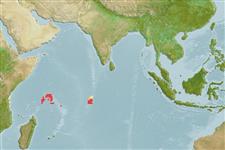>
Eupercaria/misc (Various families in series Eupercaria) >
Lethrinidae (Emperors or scavengers) > Lethrininae
Etymology: Lethrinus: Greek, lethrinia, a fish pertaining to genus Pagellus.
More on author: Smith.
Environment: milieu / climate zone / depth range / distribution range
Écologie
marin récifal; non migrateur; profondeur ? - 50 m. Tropical; 3°S - 9°S
Western Indian Ocean: known only from the Seychelles. Has been synonymized with Lethrinus mahsena.
Length at first maturity / Taille / Poids / Âge
Maturity: Lm 25.0 range ? - ? cm
Max length : 55.0 cm TL mâle / non sexé; (Ref. 2295); common length : 32.5 cm TL mâle / non sexé; (Ref. 2295)
Description synthétique
Clés d'identification | Morphologie | Morphométrie
Épines dorsales (Total) : 10; Rayons mous dorsaux (Total) : 9; Épines anales: 3; Rayons mous anaux: 8. Body is yellowish bronze or gray, becoming lighter ventrally. Sometimes three bronze stripes are on the upper side. The head is gray, brown or sometimes bronze with a series of yellowish cross stripes on the upper portion of the head and snout. A light streak radiates from the eye to the anterior nostril. the lower edge of the orbit has dark purplish spots. The maxilla is reddish. The fins are pale, yellowish or bronze.
Found over seagrass beds, coral reefs and adjacent sandy areas. Feeds mainly on echinoderms, crustaceans, and fish, and to a lesser degree on mollusks. Smaller, more numerous females than males have been confirmed for the Saya de Malta population (Ref. 2295). Marketed fresh (Ref. 171).
Life cycle and mating behavior
Maturité | Reproduction | Frai | Œufs | Fécondité | Larves
Carpenter, K.E. and G.R. Allen, 1989. FAO Species Catalogue. Vol. 9. Emperor fishes and large-eye breams of the world (family Lethrinidae). An annotated and illustrated catalogue of lethrinid species known to date. FAO Fish. Synop. 125(9):118 p. Rome: FAO. (Ref. 2295)
Statut dans la liste rouge de l'IUCN (Ref. 130435: Version 2024-1)
Menace pour l'homme
Harmless
Utilisations par l'homme
Pêcheries: commercial
Outils
Articles particuliers
Télécharger en XML
Sources Internet
Estimates based on models
Preferred temperature (Ref.
123201): 25.8 - 28.2, mean 27.6 °C (based on 10 cells).
Phylogenetic diversity index (Ref.
82804): PD
50 = 0.5000 [Uniqueness, from 0.5 = low to 2.0 = high].
Bayesian length-weight: a=0.01445 (0.00738 - 0.02832), b=2.99 (2.83 - 3.15), in cm total length, based on LWR estimates for this species & Genus-body shape (Ref.
93245).
Niveau trophique (Ref.
69278): 3.8 ±0.58 se; based on food items.
Résilience (Ref.
120179): Faible, temps minimum de doublement de population : 4,5 à 14 années (K=0.13-0.18).
Fishing Vulnerability (Ref.
59153): Moderate to high vulnerability (54 of 100).
Nutrients (Ref.
124155): Calcium = 36.1 [26.0, 48.7] mg/100g; Iron = 0.737 [0.501, 1.016] mg/100g; Protein = 20.1 [17.5, 22.3] %; Omega3 = 0.122 [0.090, 0.163] g/100g; Selenium = 41 [21, 60] μg/100g; VitaminA = 36.5 [7.9, 195.4] μg/100g; Zinc = 2.12 [1.66, 2.64] mg/100g (wet weight); based on
nutrient studies.
